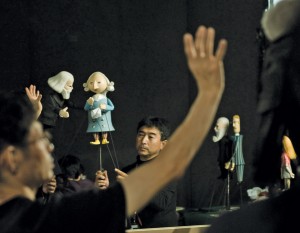« Reviews
Pedro Reyes: Baby Marx
Walker Art Center - Minneapolis
Curated by Bartholomew Ryan and Camille Washington
By Regan Golden-McNerney
The protagonists in Baby Marx are an unlikely duo-Adam Smith and Karl Marx reincarnated as wooden puppets. Baby Marx is the title of artist Pedro Reyes’ in-progress video, as well as his exhibition at the Walker Art Center that transforms the gallery into a production studio, complete with puppets, sets, and roughly edited clips. The colorful wooden puppets designed with Takumi Ota consist of simple forms with felt hair and beards. During the exhibition, Reyes is filming new scenes where Baby Marx and Smith wander the museum remarking on the value of a Warhol painting and bickering over a cookie in the cafe. Reyes slips cues into these mundane conversations about each philosopher’s ideas without being pedantic. As Reyes described in the opening discussion with contemporary political theorists, Lauren Berlant and Michael Hardt, the purpose of Baby Marx is to challenge the audience’s pre-conceived notions of Marxism. It does the same for Smith’s ideas as well. Both the film and the exhibition revolve around two central questions, what is the relevance of these ideologies today? And, can we envision an alternative to capitalism in the United States?

Pedro Reyes, Karl Marx, Adam Smith and puppeteers from the making of the Baby Marx pilot, 2009. Courtesy Detalle Films.
The weight of these questions looms over Reyes’ work, but is lessened in his videos by the enduring friendship between Marx and Smith despite philosophical differences. Oddly, the fictional friendship between these two wooden puppets humanizes the thinkers whom they represent, a remarkable feat considering both figures have been so vaunted or so violently rejected. In one scene, Baby Marx and Smith even decide to switch puppeteers causing Marx to exclaim, “Smith, I can see why you are so up tight, the invisible hand really latches on down there!” This type of humor allows Reyes to articulate important ideas from both philosophers, while also leaving the audience space for skepticism.
Although the puppets are quite abstract, their interactions make the ideas of Marx and Smith less so. This is partially the script, but also its delivery. Puppeteer Janaki Ranpura’s Smith is pompous and snooty, yet sympathetic; while puppeteer Marc Berg’s Marx is gruff and petulant, but lovable. Both characters are also baffled by their new surroundings, which diminishes their authority and alleviates the expectation that the audience would fully understand the world of Marx or Smith either. When Reyes’ uses a term from Marx or Smith the dialogue and actions of the puppets help to define and contextualize the meaning. This makes Baby Marx accessible to a broad audience and provides clarity through comedy on the divergent ideologies of Smith and Marx.
The exhibition plays a greater role in inviting viewers to envision alternatives or improvements to the current economic system in the U.S. Fodder for this “re-imagining” is provided by the “Baby Marx Town Hall,” an intense debate in the gallery (now online) between economist, Joel Waldfogel, representing Smith, and political scientist, Antonio Vázquez-Arroyo, representing Marx. In the middle of the gallery is also Reyes’ Red Cart, a book cart with texts on Socialism and Communism that viewers can peruse. While the faded red book covers suggests these texts are obsolete, their careful placement in the gallery indicates that there may be ideas to recoup.
Together the exhibition, discussions and videos reveal how narrowly focused the conversation over economic policy has become in the U.S., revolving mainly around the extent of government involvement in a capitalist system. Reyes’ exhibition suggests it is time to ask the larger, more far-reaching question, what will be the relationship between democratic institutions and capitalism in the future?
(August 11 - November 27, 2011)
Regan Golden-McNerney is an artist and writer based in Chicago.
Filed Under: Reviews


































